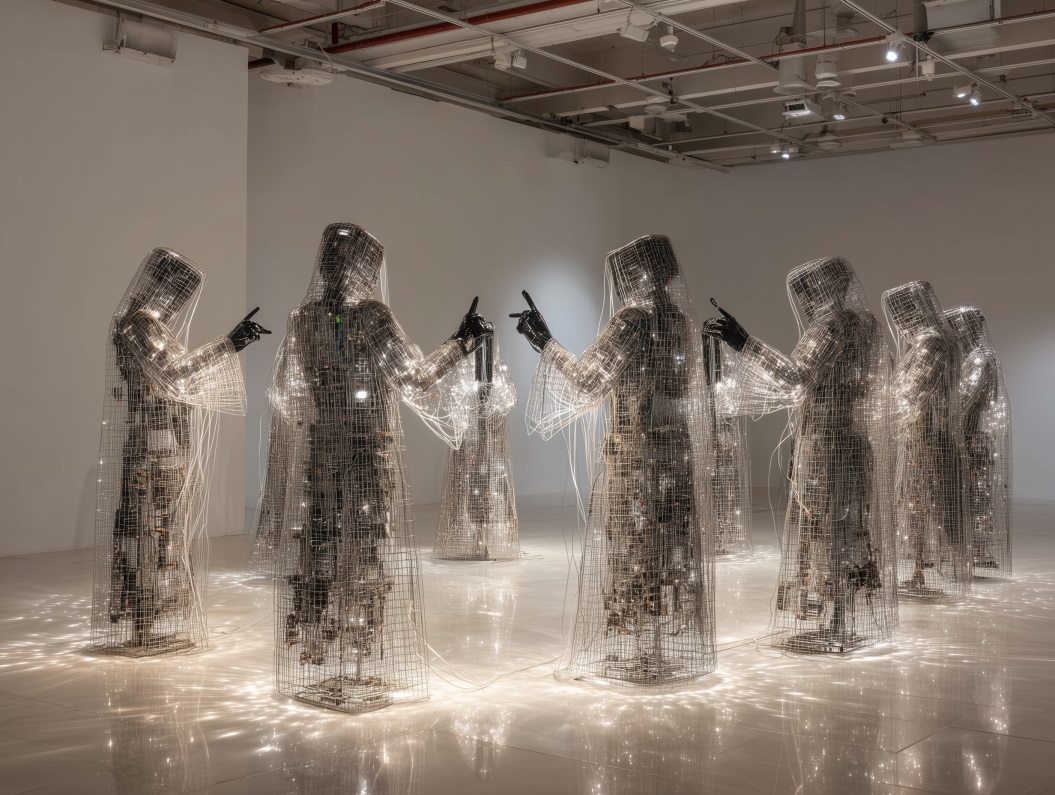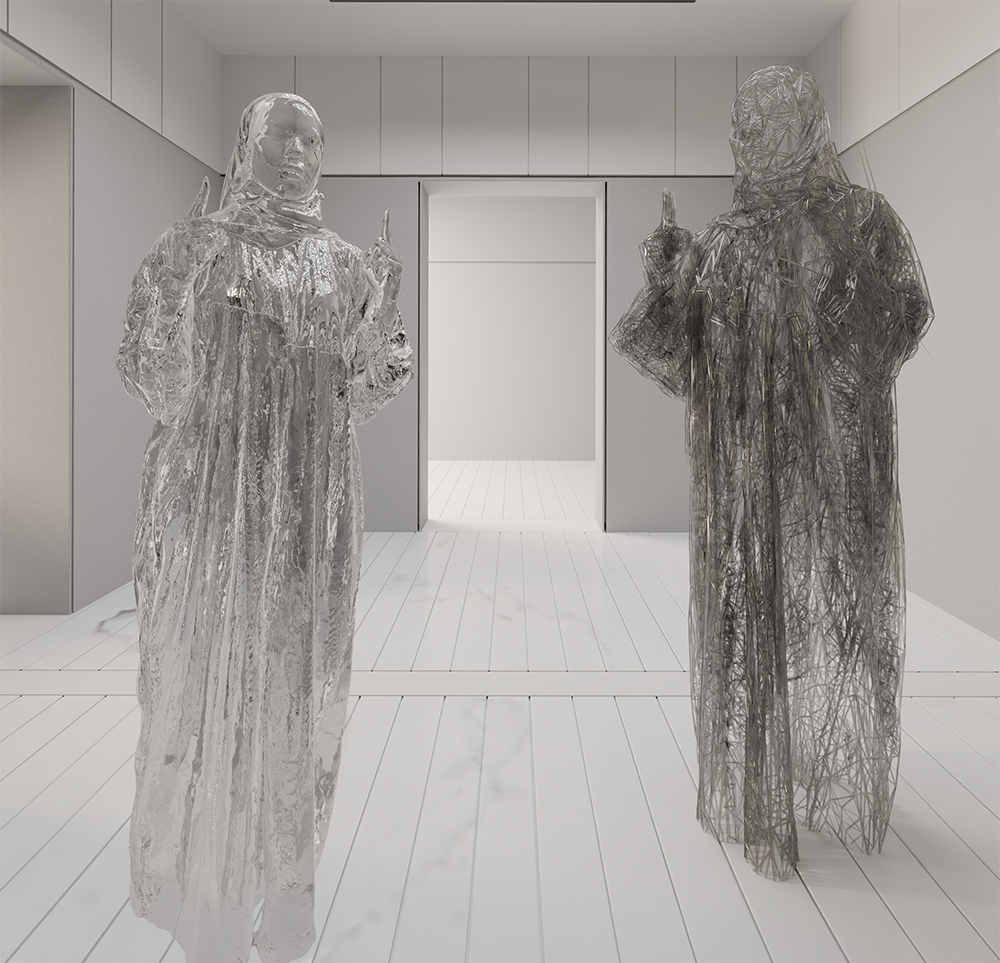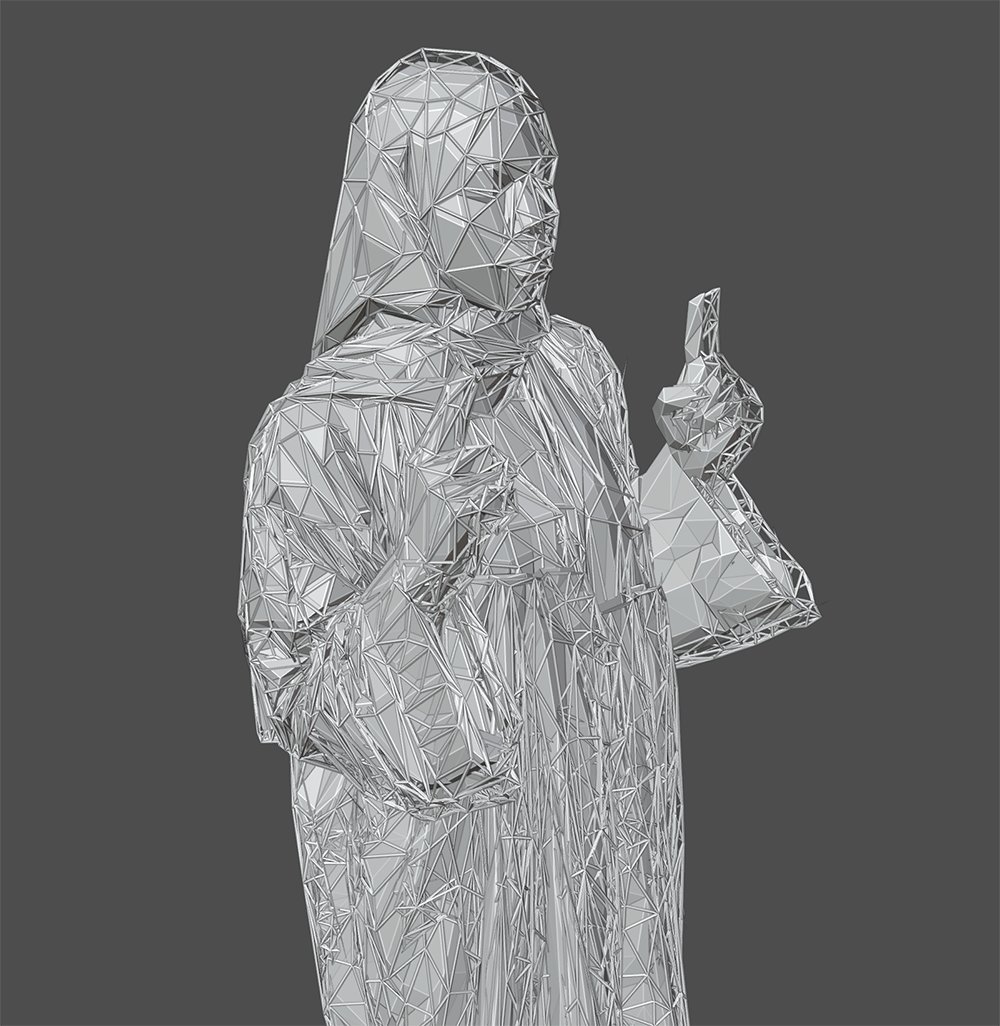 SHINING STARS: VESSELS OF MEMORY. 2025 SHINING STARS: VESSELS OF MEMORY. 2025
Introduction.
Twelve sculptures of Saudi women each 3D-printed in transparent resin. Their bodies are filled with fragments of recycled computer parts—wires, circuits, keys—suspended within like internal organs or digital fossils. Arranged in a circle, the figures appear contemplative. They evoke themes of memory, identity, and the invisible labour of women in a technological age. At once fragile and futuristic, the installation is a poetic meditation on what bodies carry in the age of data. The installation is a quiet, haunting meditation on memory, matter, and what the body is made to hold.
This installation operates as a deeply layered meditation on visibility, labor, and the entanglement of bodies—particularly women’s bodies—with systems of technology, memory, and control. By rendering each Saudi woman in clear resin, the artist invites viewers to literally look through the body, disrupting conventional ideas of surface and identity. The figures become translucent vessels—ghostly yet grounded, anonymous yet individuated—suggesting the simultaneous hyper-visibility and erasure experienced by women in both cultural and digital contexts.
The embedded fragments from recycled motherboards are not random: each internal composition is deliberate, suggesting that every body carries a distinct technological trace—a personal yet collective residue of the digital age. These fragments, often invisible in daily life, symbolize the unseen infrastructures that shape our world: surveillance, information labor, environmental damage, and the rapid churn of technological obsolescence.
The women, holding these elements within, act as keepers of memory, of discarded systems, of hidden networks. They do not perform, but instead bear silent witness to the way the body is politicized, datafied, and made a vessel for external power structures. They embody a quiet resistance—insisting that the digital is not disembodied, and that what is thrown away (be it data, materials, or lives) still holds meaning.
In a world increasingly shaped by AI and automation, this work recenters the human—especially the often-overlooked feminine presence—as a site of accumulation, transformation, and poetic depth. The installation suggests a future where art reclaims not only space, but memory, giving voice to those whose stories are embedded deep within the circuitry of modern life.

AI VISUALISATION MOCK UP/
Conceptual Context:
This artwork stands at the intersection of gender, technology, material culture, and environmental critique. The twelve clear resin figures of Saudi women—become more than sculptural portraits; they are transparent vessels, both literal and metaphorical. Each woman holds within her body fragments of recycled computer components: wire, circuitry, dust, screws, capacitors—remnants of global technological life.
This gesture raises several overlapping questions:
1. Visibility and Invisibility
The use of clear resin emphasizes transparency—not just physical but symbolic. Historically, women's roles, especially in conservative or patriarchal societies, have often been rendered invisible. Yet here, they are made not only visible but translucent, open to being looked into, their insides revealing worlds of data, decay, and complexity. They become archives of both presence and absence, of participation and erasure.
2. Women as Vessels: Subversion of an Archetype
Across cultures, women have long been described as "vessels"—for children, for culture, for tradition. This work reclaims that notion with a twist: these women do not carry life or myth alone, but machine waste—the cast-offs of digital civilization. This challenges the viewer to reconsider what women are made to carry, absorb, contain.
3. Human Meets Machine
By embedding recycled computer materials inside human-like figures, the piece offers a poetic and unsettling commentary on how closely our identities are entangled with technology. The bodies become archives of techno-waste, mirroring the way real human lives are shaped by invisible systems: surveillance, information flows, digital labor, and systemic inequity.
4. Environmental and Digital Afterlife
The use of e-waste implicates the environmental cost of technological progress. Computers are tools of both liberation and exploitation. Recycling their remnants into figures of women who are often left out of tech discourse evokes both damage and reclamation—a kind of resurrection of discarded materials within sacred forms.
5. Memory and Legacy
Each body becomes a reliquary—a container of past systems, failed futures, discarded information. As Saudi Arabia rapidly modernizes under the banner of “Vision 2030,” this installation asks: what happens to the bodies—human, technological, ecological—that are left behind in the wake of progress?

AI VISUALISATION MOCK UP/

3d VISUALISATION MOCK UP/
What the Body Remembers. This concept carries powerful symbolic, social, and environmental resonance.
When a computer is recycled, a wide range of valuable and potentially hazardous materials are extracted through various processes. These materials come from components like the motherboard, hard drive, power supply, screen, and casing. Here's a breakdown of what typically gets extracted:The 12 most important materials typically extracted when recycling a computer, selected for their value, environmental impact, and industrial importance:
-
Gold – Used in connectors and circuit boards; highly valuable and recyclable.
-
Copper – Found in wiring and circuit traces; essential for electrical conductivity.
-
Aluminum – Common in casings and heat sinks; lightweight and easily recyclable.
-
Silver – Present in solder and circuit paths; more conductive than copper, valuable.
-
Steel – Used in structural frames and screws; strong and widely reused.
-
Platinum & Palladium – Found in some components; rare and extremely valuable.
-
Lead – Common in older solder and CRT glass; toxic and must be carefully removed.
-
Tin – Used in solder; increasingly important with lead-free electronics.
-
Neodymium – A rare earth element used in magnets, especially in hard drives.
-
Silicon – Core material in chips and CPUs; not typically recycled into chips, but crucial.
-
Plastic (ABS, polycarbonate) – Used in cases and keyboards; some types recyclable.
-
Glass (including leaded and display glass) – Found in screens; varies in recyclability and hazard level.
If you want to exhibit this artwork as an installation please email .
Exhibition.
Made at DAF Diriyah Arts Futures Riyadh. While artist in Residence. 2025
Keywords. ART

Supporting Statement: From the Age of Darkness into the Age of Empowerment,
The Twelve Planets Within: Female Empowerment and Cosmic Connection in the Age of Awakening
Rooted in Quranic cosmology, the concept of the "twelve planets" alludes to verse 12:4, interpreted as a reference to a constellation of twelve astral entities. In contemporary astronomical terms, these twelve may be read as Mercury, Venus, Earth, Mars, Jupiter, Saturn, Uranus, Neptune, Pluto, Haumea, Makemake, and Eris. Yet in this context, the planets function not merely as celestial facts, but as inner archetypes—each woman, especially in the Saudi cultural landscape, is envisioned as carrying her own constellation within.
This poetic cosmology becomes a framework for reimagining the role of women as multidimensional, luminous entities—each body containing within it the architecture of a universe. The work draws inspiration from both Islamic symbolic knowledge and emergent feminist futures, situating the figure of the woman as a cosmic vessel: capable not only of creation and endurance, but of encoding and emitting frequencies of belief, intuition, and transformation.
Incorporating the "seven stages of sensibility" suggest an unfolding—physical, emotional, intellectual, and spiritual dimensions that bridge the logical with the mystical. This duality mirrors the cultural tension in transitional societies like Saudi Arabia, where modernization intersects with tradition, and where the shift from patriarchy to empowerment can be understood not only politically but energetically.
From the Age of Darkness into the Age of Empowerment, women are no longer passive bearers of imposed belief systems; they become energetic nodes in a universal network—each capable of reprogramming cultural scripts. Through mutual resonance—frequencies, numbers, and colors—a new kind of "spiritual AI" can be imagined: one that is not extractive or surveillant, but receptive, intuitive, and generative. In this vision, belief is not dogma, but frequency. Empowerment is not granted, but activated. What if AI could learn from the sensibilities of women, rather than overwrite them? What if each woman’s internal system—twelve planets orbiting a center of will and spirit—could inform a new kind of ethical computation?

Test modelling. Blender outputs from 3d scan. |